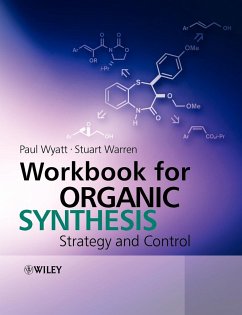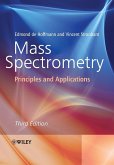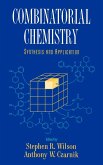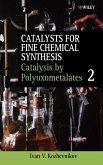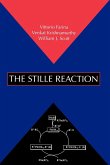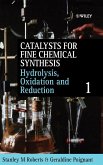Stuart Warren
Workbook for Organic Synthesis
Stuart Warren
Workbook for Organic Synthesis
- Broschiertes Buch
- Merkliste
- Auf die Merkliste
- Bewerten Bewerten
- Teilen
- Produkt teilen
- Produkterinnerung
- Produkterinnerung
This workbook accompanies Organic Synthesis: Strategy and Control, the bestselling advanced organic chemistry textbook. The workbook provides a complete course for advanced organic chemistry students and includes a graded set of problems, solutions, and discussions to illustrate and develop the themes of each of the chapters in the textbook.
Andere Kunden interessierten sich auch für
![Mass Spectrometry Mass Spectrometry]() James BarkerMass Spectrometry62,99 €
James BarkerMass Spectrometry62,99 €![Combinatorial Chemistry Combinatorial Chemistry]() Stephen R. Wilson / Anthony W. Czarnik (Hgg.)Combinatorial Chemistry173,99 €
Stephen R. Wilson / Anthony W. Czarnik (Hgg.)Combinatorial Chemistry173,99 €![Catalysis by Polyoxometalates, Volume 2 Catalysis by Polyoxometalates, Volume 2]() Ivan KozhevnikovCatalysis by Polyoxometalates, Volume 2311,99 €
Ivan KozhevnikovCatalysis by Polyoxometalates, Volume 2311,99 €![The Stille Reaction The Stille Reaction]() Vittorio FarinaThe Stille Reaction162,99 €
Vittorio FarinaThe Stille Reaction162,99 €![Catalysts for Fine Chemical Synthesis, 5 Volume Set Catalysts for Fine Chemical Synthesis, 5 Volume Set]() Stanley M. RobertsCatalysts for Fine Chemical Synthesis, 5 Volume Set1.088,99 €
Stanley M. RobertsCatalysts for Fine Chemical Synthesis, 5 Volume Set1.088,99 €![Hydrolysis, Oxidation and Reduction, Volume 1 Hydrolysis, Oxidation and Reduction, Volume 1]() Stan M. Roberts / Geraldine Poignant (Hgg.)Hydrolysis, Oxidation and Reduction, Volume 1266,99 €
Stan M. Roberts / Geraldine Poignant (Hgg.)Hydrolysis, Oxidation and Reduction, Volume 1266,99 €![General Aspects of the Chemistry of Radicals General Aspects of the Chemistry of Radicals]() Zeev B. Alfassi (Hrsg.)General Aspects of the Chemistry of Radicals828,99 €
Zeev B. Alfassi (Hrsg.)General Aspects of the Chemistry of Radicals828,99 €-
-
-
This workbook accompanies Organic Synthesis: Strategy and Control, the bestselling advanced organic chemistry textbook. The workbook provides a complete course for advanced organic chemistry students and includes a graded set of problems, solutions, and discussions to illustrate and develop the themes of each of the chapters in the textbook.
Hinweis: Dieser Artikel kann nur an eine deutsche Lieferadresse ausgeliefert werden.
Hinweis: Dieser Artikel kann nur an eine deutsche Lieferadresse ausgeliefert werden.
Produktdetails
- Produktdetails
- Verlag: Wiley & Sons
- 1. Auflage
- Seitenzahl: 502
- Erscheinungstermin: 21. April 2008
- Englisch
- Abmessung: 246mm x 189mm x 27mm
- Gewicht: 965g
- ISBN-13: 9780471929642
- ISBN-10: 0471929646
- Artikelnr.: 15178024
- Herstellerkennzeichnung
- Books on Demand GmbH
- In de Tarpen 42
- 22848 Norderstedt
- info@bod.de
- 040 53433511
- Verlag: Wiley & Sons
- 1. Auflage
- Seitenzahl: 502
- Erscheinungstermin: 21. April 2008
- Englisch
- Abmessung: 246mm x 189mm x 27mm
- Gewicht: 965g
- ISBN-13: 9780471929642
- ISBN-10: 0471929646
- Artikelnr.: 15178024
- Herstellerkennzeichnung
- Books on Demand GmbH
- In de Tarpen 42
- 22848 Norderstedt
- info@bod.de
- 040 53433511
Dr Paul Wyatt, School of Chemistry, University of Bristol, Bristol Dr Wyatt is Director of Undergraduate Studies for the School of Chemistry at Bristol University and also Director of BRISTOL ChemLabS - a HEFCE Centre for Excellence in Teaching & Learning. Dr Stuart Warren, Department of Chemistry, University of Cambridge, Lensfield Road, Cambridge Dr Warren is the author of the bestselling textbooks Organic Synthesis: The Disconnection Approach (Wiley) and Organic Synthesis (OUP)
Preface. A. Introduction: Selectivity. 1. Planning Organic Syntheses:
Tactics, Strategy and Control. 2. Chemoselectivity. 3. Regioselectivity:
Controlled Aldol Reactions. 4. Stereoselectivity: Stereoselective Aldol
Reactions. 5. Alternative Strategies for Enone Synthesis. 6. Choosing a
Strategy: The Synthesis of Cyclopentenones. B. Making Carbon-Carbon Bonds.
7. The Ortho Strategy for Aromatic Compounds. 8. -complexes of Metals. 9.
Controlling the Michael Reaction. 10. Specific Enol Equivalents. 12. Allyl
Anions. 13. Homoenolates. 14. Acyl Anion Equivalents. C. Carbon-Carbon
Double Bonds. 15. Synthesis of Double Bonds of Defined Stereochemistry. 16.
Vinyl Anions. 17. Electrophilic Attack on Alkenes. 18. Vinyl Cations. 19.
Allyl Alcohols: Allyl Cation Equivalents (and More). D. Stereochemistry.
20. Control of Stereochemistry - Introduction. 21. Diastereoselectivity.
22. Resolution. 23. The Chiral Pool: Asymmetric Synthesis with Natural
Products as Starting Materials. 24. Asymmetric Induction I: Reagent-Based
Strategy. 25. Asymmetric Induction II: Asymmetric Catalysis: Formation of
C-O and C-N Bonds. 26. Asymmetric Induction III: Asymmetric Catalysis:
Formation of C-H and C-C Bonds. 27. Asymmetric Induction IV:
Substrate-Based Strategy. 28. Kinetic Resolution. 29. Enzymes: biological
Methods in Asymmetric Synthesis. 30. New Chiral Centres from Old:
Enantiomerically Pure Compounds and Sophisticated Syntheses. 31. Strategy
of Asymmetric Synthesis. E. Functional Group Strategy. 32.
Functionalisation of Pyridine. 33. Oxidation of Aromatic Rings and of
Enol(ate)s. 34. Functionality and Pericyclic Reactions: Nitrogen
Heterocycles by Cycloadditions and Sigmatropic Rearrangements. 35.
Synthesis and Chemistry of Azoles and other Heterocycles with Two or more
Heteroatoms. 36. Tandem Organic Reactions. Index.
Tactics, Strategy and Control. 2. Chemoselectivity. 3. Regioselectivity:
Controlled Aldol Reactions. 4. Stereoselectivity: Stereoselective Aldol
Reactions. 5. Alternative Strategies for Enone Synthesis. 6. Choosing a
Strategy: The Synthesis of Cyclopentenones. B. Making Carbon-Carbon Bonds.
7. The Ortho Strategy for Aromatic Compounds. 8. -complexes of Metals. 9.
Controlling the Michael Reaction. 10. Specific Enol Equivalents. 12. Allyl
Anions. 13. Homoenolates. 14. Acyl Anion Equivalents. C. Carbon-Carbon
Double Bonds. 15. Synthesis of Double Bonds of Defined Stereochemistry. 16.
Vinyl Anions. 17. Electrophilic Attack on Alkenes. 18. Vinyl Cations. 19.
Allyl Alcohols: Allyl Cation Equivalents (and More). D. Stereochemistry.
20. Control of Stereochemistry - Introduction. 21. Diastereoselectivity.
22. Resolution. 23. The Chiral Pool: Asymmetric Synthesis with Natural
Products as Starting Materials. 24. Asymmetric Induction I: Reagent-Based
Strategy. 25. Asymmetric Induction II: Asymmetric Catalysis: Formation of
C-O and C-N Bonds. 26. Asymmetric Induction III: Asymmetric Catalysis:
Formation of C-H and C-C Bonds. 27. Asymmetric Induction IV:
Substrate-Based Strategy. 28. Kinetic Resolution. 29. Enzymes: biological
Methods in Asymmetric Synthesis. 30. New Chiral Centres from Old:
Enantiomerically Pure Compounds and Sophisticated Syntheses. 31. Strategy
of Asymmetric Synthesis. E. Functional Group Strategy. 32.
Functionalisation of Pyridine. 33. Oxidation of Aromatic Rings and of
Enol(ate)s. 34. Functionality and Pericyclic Reactions: Nitrogen
Heterocycles by Cycloadditions and Sigmatropic Rearrangements. 35.
Synthesis and Chemistry of Azoles and other Heterocycles with Two or more
Heteroatoms. 36. Tandem Organic Reactions. Index.
Section A: Introduction: Selectivity
1. Planning Organic Syntheses: Tactics, Strategy and Control
2. Chemoselectivity
3. Regioselectivity: Controlled Aldol Reactions
4. Stereoselectivity: Stereoselective Aldol Reactions
5. Alternative Strategies for Enone Synthesis
6. Choosing a Strategy: The Synthesis of Cyclopentenones
Section B: Making Carbon-Carbon Bonds
7. The Ortho Strategy for Aromatic Compounds
8. s-Complexes of Metals
9. Controlling the Michael Reaction
10. Specific Enol Equivalents
11. Extended Enolates
12. Allyl Anions
13. Homoenolates
14. Acyl Anion Equivalents
Section C: Carbon-Carbon Double Bonds
15. Synthesis of Double Bonds of Defined Stereochemistry
16. Vinyl Anions
17. Electrophilic Attack on Alkenes
18. Vinyl Cations
19. Allyl Alcohols: Allyl Cation Equivalents (and More)
Section D: Stereochemistry
20. Control of Stereochemistry -- Introduction
21. Diastereoselectivity
22. Resolution
23. The Chiral Pool: Asymmetric Synthesis with Natural Products as Starting Materials
24. Asymmetric Induction I: Reagent-Based Strategy
25. Asymmetric Induction II: Asymmetric Catalysis: Formation of C-O and C-N Bonds
26. Asymmetric Induction III: Asymmetric Catalysis: Formation of C-H and C-C Bonds
27. Asymmetric Induction IV: Substrate-Based Strategy
28. Kinetic Resolution
29. Enzymes: Biological Methods in Asymmetric Synthesis
30. New Chiral Centres from Old: Enantiomerically Pure Compounds & Sophisticated Syntheses
31. Strategy of Asymmetric Synthesis
Section E: Functional Group Strategy
32. Functionalisation of Pyridine
33. Oxidation of Aromatic Rings and of Enol(ate)s
34. Functionality and Pericyclic Reactions: Nitrogen Heterocycles by Cycloadditions and Sigmatropic Rearrangements
35. Synthesis and Chemistry of Azoles and other Heterocycles with Two or more Heteroatoms
36. Tandem Organic Reactions
1. Planning Organic Syntheses: Tactics, Strategy and Control
2. Chemoselectivity
3. Regioselectivity: Controlled Aldol Reactions
4. Stereoselectivity: Stereoselective Aldol Reactions
5. Alternative Strategies for Enone Synthesis
6. Choosing a Strategy: The Synthesis of Cyclopentenones
Section B: Making Carbon-Carbon Bonds
7. The Ortho Strategy for Aromatic Compounds
8. s-Complexes of Metals
9. Controlling the Michael Reaction
10. Specific Enol Equivalents
11. Extended Enolates
12. Allyl Anions
13. Homoenolates
14. Acyl Anion Equivalents
Section C: Carbon-Carbon Double Bonds
15. Synthesis of Double Bonds of Defined Stereochemistry
16. Vinyl Anions
17. Electrophilic Attack on Alkenes
18. Vinyl Cations
19. Allyl Alcohols: Allyl Cation Equivalents (and More)
Section D: Stereochemistry
20. Control of Stereochemistry -- Introduction
21. Diastereoselectivity
22. Resolution
23. The Chiral Pool: Asymmetric Synthesis with Natural Products as Starting Materials
24. Asymmetric Induction I: Reagent-Based Strategy
25. Asymmetric Induction II: Asymmetric Catalysis: Formation of C-O and C-N Bonds
26. Asymmetric Induction III: Asymmetric Catalysis: Formation of C-H and C-C Bonds
27. Asymmetric Induction IV: Substrate-Based Strategy
28. Kinetic Resolution
29. Enzymes: Biological Methods in Asymmetric Synthesis
30. New Chiral Centres from Old: Enantiomerically Pure Compounds & Sophisticated Syntheses
31. Strategy of Asymmetric Synthesis
Section E: Functional Group Strategy
32. Functionalisation of Pyridine
33. Oxidation of Aromatic Rings and of Enol(ate)s
34. Functionality and Pericyclic Reactions: Nitrogen Heterocycles by Cycloadditions and Sigmatropic Rearrangements
35. Synthesis and Chemistry of Azoles and other Heterocycles with Two or more Heteroatoms
36. Tandem Organic Reactions
Preface. A. Introduction: Selectivity. 1. Planning Organic Syntheses:
Tactics, Strategy and Control. 2. Chemoselectivity. 3. Regioselectivity:
Controlled Aldol Reactions. 4. Stereoselectivity: Stereoselective Aldol
Reactions. 5. Alternative Strategies for Enone Synthesis. 6. Choosing a
Strategy: The Synthesis of Cyclopentenones. B. Making Carbon-Carbon Bonds.
7. The Ortho Strategy for Aromatic Compounds. 8. -complexes of Metals. 9.
Controlling the Michael Reaction. 10. Specific Enol Equivalents. 12. Allyl
Anions. 13. Homoenolates. 14. Acyl Anion Equivalents. C. Carbon-Carbon
Double Bonds. 15. Synthesis of Double Bonds of Defined Stereochemistry. 16.
Vinyl Anions. 17. Electrophilic Attack on Alkenes. 18. Vinyl Cations. 19.
Allyl Alcohols: Allyl Cation Equivalents (and More). D. Stereochemistry.
20. Control of Stereochemistry - Introduction. 21. Diastereoselectivity.
22. Resolution. 23. The Chiral Pool: Asymmetric Synthesis with Natural
Products as Starting Materials. 24. Asymmetric Induction I: Reagent-Based
Strategy. 25. Asymmetric Induction II: Asymmetric Catalysis: Formation of
C-O and C-N Bonds. 26. Asymmetric Induction III: Asymmetric Catalysis:
Formation of C-H and C-C Bonds. 27. Asymmetric Induction IV:
Substrate-Based Strategy. 28. Kinetic Resolution. 29. Enzymes: biological
Methods in Asymmetric Synthesis. 30. New Chiral Centres from Old:
Enantiomerically Pure Compounds and Sophisticated Syntheses. 31. Strategy
of Asymmetric Synthesis. E. Functional Group Strategy. 32.
Functionalisation of Pyridine. 33. Oxidation of Aromatic Rings and of
Enol(ate)s. 34. Functionality and Pericyclic Reactions: Nitrogen
Heterocycles by Cycloadditions and Sigmatropic Rearrangements. 35.
Synthesis and Chemistry of Azoles and other Heterocycles with Two or more
Heteroatoms. 36. Tandem Organic Reactions. Index.
Tactics, Strategy and Control. 2. Chemoselectivity. 3. Regioselectivity:
Controlled Aldol Reactions. 4. Stereoselectivity: Stereoselective Aldol
Reactions. 5. Alternative Strategies for Enone Synthesis. 6. Choosing a
Strategy: The Synthesis of Cyclopentenones. B. Making Carbon-Carbon Bonds.
7. The Ortho Strategy for Aromatic Compounds. 8. -complexes of Metals. 9.
Controlling the Michael Reaction. 10. Specific Enol Equivalents. 12. Allyl
Anions. 13. Homoenolates. 14. Acyl Anion Equivalents. C. Carbon-Carbon
Double Bonds. 15. Synthesis of Double Bonds of Defined Stereochemistry. 16.
Vinyl Anions. 17. Electrophilic Attack on Alkenes. 18. Vinyl Cations. 19.
Allyl Alcohols: Allyl Cation Equivalents (and More). D. Stereochemistry.
20. Control of Stereochemistry - Introduction. 21. Diastereoselectivity.
22. Resolution. 23. The Chiral Pool: Asymmetric Synthesis with Natural
Products as Starting Materials. 24. Asymmetric Induction I: Reagent-Based
Strategy. 25. Asymmetric Induction II: Asymmetric Catalysis: Formation of
C-O and C-N Bonds. 26. Asymmetric Induction III: Asymmetric Catalysis:
Formation of C-H and C-C Bonds. 27. Asymmetric Induction IV:
Substrate-Based Strategy. 28. Kinetic Resolution. 29. Enzymes: biological
Methods in Asymmetric Synthesis. 30. New Chiral Centres from Old:
Enantiomerically Pure Compounds and Sophisticated Syntheses. 31. Strategy
of Asymmetric Synthesis. E. Functional Group Strategy. 32.
Functionalisation of Pyridine. 33. Oxidation of Aromatic Rings and of
Enol(ate)s. 34. Functionality and Pericyclic Reactions: Nitrogen
Heterocycles by Cycloadditions and Sigmatropic Rearrangements. 35.
Synthesis and Chemistry of Azoles and other Heterocycles with Two or more
Heteroatoms. 36. Tandem Organic Reactions. Index.
Section A: Introduction: Selectivity
1. Planning Organic Syntheses: Tactics, Strategy and Control
2. Chemoselectivity
3. Regioselectivity: Controlled Aldol Reactions
4. Stereoselectivity: Stereoselective Aldol Reactions
5. Alternative Strategies for Enone Synthesis
6. Choosing a Strategy: The Synthesis of Cyclopentenones
Section B: Making Carbon-Carbon Bonds
7. The Ortho Strategy for Aromatic Compounds
8. s-Complexes of Metals
9. Controlling the Michael Reaction
10. Specific Enol Equivalents
11. Extended Enolates
12. Allyl Anions
13. Homoenolates
14. Acyl Anion Equivalents
Section C: Carbon-Carbon Double Bonds
15. Synthesis of Double Bonds of Defined Stereochemistry
16. Vinyl Anions
17. Electrophilic Attack on Alkenes
18. Vinyl Cations
19. Allyl Alcohols: Allyl Cation Equivalents (and More)
Section D: Stereochemistry
20. Control of Stereochemistry -- Introduction
21. Diastereoselectivity
22. Resolution
23. The Chiral Pool: Asymmetric Synthesis with Natural Products as Starting Materials
24. Asymmetric Induction I: Reagent-Based Strategy
25. Asymmetric Induction II: Asymmetric Catalysis: Formation of C-O and C-N Bonds
26. Asymmetric Induction III: Asymmetric Catalysis: Formation of C-H and C-C Bonds
27. Asymmetric Induction IV: Substrate-Based Strategy
28. Kinetic Resolution
29. Enzymes: Biological Methods in Asymmetric Synthesis
30. New Chiral Centres from Old: Enantiomerically Pure Compounds & Sophisticated Syntheses
31. Strategy of Asymmetric Synthesis
Section E: Functional Group Strategy
32. Functionalisation of Pyridine
33. Oxidation of Aromatic Rings and of Enol(ate)s
34. Functionality and Pericyclic Reactions: Nitrogen Heterocycles by Cycloadditions and Sigmatropic Rearrangements
35. Synthesis and Chemistry of Azoles and other Heterocycles with Two or more Heteroatoms
36. Tandem Organic Reactions
1. Planning Organic Syntheses: Tactics, Strategy and Control
2. Chemoselectivity
3. Regioselectivity: Controlled Aldol Reactions
4. Stereoselectivity: Stereoselective Aldol Reactions
5. Alternative Strategies for Enone Synthesis
6. Choosing a Strategy: The Synthesis of Cyclopentenones
Section B: Making Carbon-Carbon Bonds
7. The Ortho Strategy for Aromatic Compounds
8. s-Complexes of Metals
9. Controlling the Michael Reaction
10. Specific Enol Equivalents
11. Extended Enolates
12. Allyl Anions
13. Homoenolates
14. Acyl Anion Equivalents
Section C: Carbon-Carbon Double Bonds
15. Synthesis of Double Bonds of Defined Stereochemistry
16. Vinyl Anions
17. Electrophilic Attack on Alkenes
18. Vinyl Cations
19. Allyl Alcohols: Allyl Cation Equivalents (and More)
Section D: Stereochemistry
20. Control of Stereochemistry -- Introduction
21. Diastereoselectivity
22. Resolution
23. The Chiral Pool: Asymmetric Synthesis with Natural Products as Starting Materials
24. Asymmetric Induction I: Reagent-Based Strategy
25. Asymmetric Induction II: Asymmetric Catalysis: Formation of C-O and C-N Bonds
26. Asymmetric Induction III: Asymmetric Catalysis: Formation of C-H and C-C Bonds
27. Asymmetric Induction IV: Substrate-Based Strategy
28. Kinetic Resolution
29. Enzymes: Biological Methods in Asymmetric Synthesis
30. New Chiral Centres from Old: Enantiomerically Pure Compounds & Sophisticated Syntheses
31. Strategy of Asymmetric Synthesis
Section E: Functional Group Strategy
32. Functionalisation of Pyridine
33. Oxidation of Aromatic Rings and of Enol(ate)s
34. Functionality and Pericyclic Reactions: Nitrogen Heterocycles by Cycloadditions and Sigmatropic Rearrangements
35. Synthesis and Chemistry of Azoles and other Heterocycles with Two or more Heteroatoms
36. Tandem Organic Reactions

